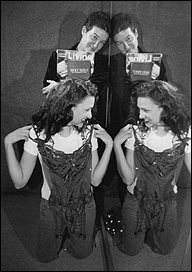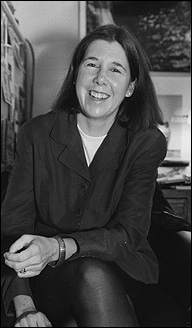![]()
Departments
Arts
![]()

|
Week of 6 November 1998 |
Vol. II, No. 13 |
Arts
Seven Deadly Sins
SFA presenting last major Weill-Brecht collaboration
By Judith Sandler
The last major collaboration of composer Kurt Weill and playwright Bertolt Brecht is one of those minor masterpieces that evaporated after its premiere. The Seven Deadly Sins -- which was premiered in Paris in 1933 after Brecht and Weill had fled Germany and didn't fully catch on again until the past decade -- will be presented this week by the Boston University Opera Institute. Although Brecht dismissed the collaboration, a commission from George Balanchine, many critics consider Weill's score to represent the peak of his European output (he immigrated to the United States in 1935).
Split personality: Suzanne
Ehly (top) and Sandra Eddy alternate in the role of
Anna I and Anna II in the Opera Institute
production of the final major Weill-Brecht
collaboration, The Seven Deadly Sins.
Photo by Morgan Segal
"The story is about a young woman, Anna, who
embarks on a seven-year journey to seven different cities to
earn enough money for her family to buy a house in
Louisiana," says Allison Voth, the musical director and SFA
assistant professor. "Along the way she encounters the seven
deadly sins, one in each city."

The woman is portrayed by two performers, Anna I, who sings, and Anna II, who communicates through speech and movement. Anna I represents the rational side, Anna II the more impulsive. "The two personalities signify people morally split between two parts of themselves," says Todd Olson, the stage director. "The opera is about the internal struggle to live by the rules versus internal urges."
"It's extremely helpful to understand each Anna by playing her opposite," says Sandra Eddy (SFA'99), a master's student who alternates the roles of Anna I and II with Suzanne Ehly (SFA'99), a student at the Opera Institute. "One is logical and her movements are straight and structured. The other is emotional and off in her own little world; her movements are curvy and free."
Brecht and Weill wrote The Seven Deadly Sins in part as a satire on America, according to Olson. Although neither artist had visited the United States, he says, "the whole American mythology was important to them. I think it represented freedom and excess -- a place where people could do what they wanted. Brecht and Weill explored what lengths people would go to in order to get what they wanted."
|
The three other operas making up the Fringe Festival are: |
|
The Boor November 13-15, 7 p.m., November 15, 3 p.m. |
|
The Village Singer November 20-22, 7 p.m., November 22, 3 p.m. |
|
Dido and Aeneas Thursday, March 4, 8 p.m. |
"We are intertwining music and movement," Voth says. "Without a choreographer on board, the singers created much of the movement themselves. The process of evolution has been fascinating to watch."
Weill's dark score synthesizes the popular songs of the time with his classical training. "The singing style is similar to cabaret," says Ehly. "The vocal line is very close to the text; it's on the edge of speech." Eddy says she is glad they are singing in English because "the words are the essence of the piece." (Brecht wrote the piece in German.)
"There's great richness in the rhythms and harmonies," says Ehly. "It was conceived as a ballet chanté, so there's lots of dance music -- waltzes, foxtrots, tarantellas. Weill used harmonies and colors to comment on the absurdities and twisted quality of Brecht's text."
Because The Seven Deadly Sins runs only 35 minutes, the directors have paired it with a cabaret-style program of other Brecht/Weill songs.
The Seven Deadly Sins is the opening work of the four-event Opera Institute Fringe Festival, conceived by Institute Director Sharon Daniels as a celebration of one-act operas. "The Fringe Festival was designed to complement our two fully produced mainstage operas," she says. "It also gives singers the experience of creating and developing the character for a full role, rather than just performing scenes and arias from different operas. And because opera companies need to mount large-scale productions in order to keep their houses full, they don't have the luxury of exploring these little gems."
The Seven Deadly Sins, with music by Kurt Weill, text by Bertolt Brecht, and English translation by W. H. Auden and Chester Kallman, will be presented in the Boston University Theatre Studio 210, November 6 through 8 at 7 p.m., and November 8 at 3 p.m. Todd Olson is the stage director and Allison Voth is the musical director. Admission is $5 to the general public and free to the Boston University community.
Before the Lens: Images of the Imagemakers
Focus on milestones of developing visions
By J. Nicole Long
"I'm fascinated by art, but I'm not technically adept at making it," says Karen Haas. "I go along with the theory that art historians are frustrated artists."
Haas (GRS'96), appointed curator of the BU Art Gallery in September, arranged Before the Lens: Images of the Imagemakers, a touring photography exhibition that started at the New Hampshire Institute of Art and will be at BU through December 13.
A historical survey, Before the Lens demonstrates changing technology, and its theme is the cast of characters who significantly contributed to developments in technique, style, or sensibility -- William Henry Jackson, an official photographer for the U.S. Geological and Geographical Survey of the Territories, whose images of Yellowstone were instrumental in establishing America's first National Park, in 1872; Lotte Jacobi, well-known for portraits of artists, such as writers Thomas Mann and Bertolt Brecht; and Lewis Carroll, who, in addition to writing Alice in Wonderland, photographed young girls. Some of the photographs are self-portraits, and some were taken by little-known or anonymous artists.
|
|
|
Karen Haas |
Haas worked at the Isabella Stewart Gardner Museum for 13 years before entering a master's program at BU. When she began her studies, she left the Gardner and became a freelance curator, working part-time at various museums, among them the Museum of Fine Arts and Andover's Addison Gallery of American Art. Additionally, she is responsible for a number of private collections, including the Lane Collection of photographs housed at the MFA. She has also taught art history classes and written several articles.
"My first freelance assignment was a show called The Lure of Italy at the MFA," Haas says. "At the Gardner I gained a lot of experience working with a permanent collection -- conservation, museum policy, and all kinds of related issues -- but the MFA project was my first experience working with changing exhibitions. I like hanging shows -- it utilizes my creativity."
At BU, Haas will work exclusively with changing exhibitions. With Before the Lens, she faced the challenge of hanging an exhibition composed of many small photographs. "It's easy for the space of the walls to swallow them up," she says. Framed in what looks like a small leather compact, Daguerreotype Studio in the Garden of Jabez Hogg's Home, Grove Cottage was the most difficult piece to display, according to Haas. "You can hold it in the palm of your hand," she says.
Haas met all of the challenges, however. "I feel like it's Christmas," she says. "It's a rare opportunity to see how photographers see themselves, and how they were seen by others. We're happy to do a survey of this kind at BU -- it's a little different for us."
